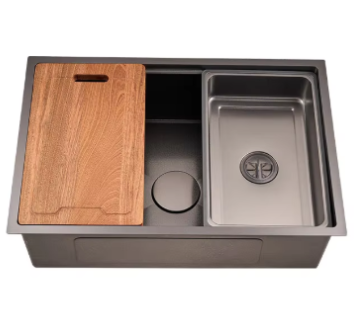Initial Investment vs. Long-Term Savings of Handmade Sinks
Upfront Costs of Artisan Craftsmanship
When considering handmade sinks, the initial investment is often a point of interest. Artisan sinks, made from high-quality materials and distinguished by intricate designs, typically range from $300 to $2,000. This price range reflects the bespoke craftsmanship and the absence of mass production standardization, which provides each sink with unique aesthetic qualities. For homeowners planning kitchen or bathroom remodels, understanding these upfront costs is crucial for effective budget allocation. The quality of materials used and the labor-intensive process explain the higher initial price, which pays off by offering exclusive design and durability.
Reduced Replacement Expenses Over Time
Investing in handmade sinks can result in significant long-term savings through reduced replacement expenses. Quality handmade sinks generally last longer than their mass-produced counterparts due to superior materials and craftsmanship, potentially saving homeowners up to 30% on replacement costs over a decade. This durability comes from their resistance to common issues like chipping, cracking, or staining. By conducting a cost-benefit analysis, it becomes clear that while the initial costs may be higher, they can lead to financial savings in the long run by minimizing repair and replacement frequency. Therefore, an investment in quality yields enduring benefits, making handmade sinks a sensible financial choice for long-term savings.
Durability and Craftsmanship in Custom Sinks
Superior Materials for Extended Lifespan
The durability of custom sinks is largely attributed to the high-quality materials from which they are crafted. Unlike standard factory-made options, custom sinks are often made from superior materials such as copper, granite, or high-grade stainless steel, each known for its enhanced strength and longevity. These materials are specifically chosen for their ability to withstand daily wear and tear, offering better resistance to corrosion and stains over time. It's not uncommon for a well-maintained custom sink to last over 50 years, turning what might seem like a higher initial investment into a cost-effective choice in the long run. The superior quality not only prolongs the life of the sink but also supports its visual appeal.
Handcrafted Construction vs. Mass-Produced Flaws
When it comes to craftsmanship, the distinction between handcrafted sinks and mass-produced sinks is quite evident. Handcrafted sinks benefit from the artisan's meticulous attention to detail, ensuring that each piece is unique and free of the defects often found in mass-produced items. This level of craftsmanship results in a product that is both aesthetically pleasing and functionally reliable. Many consumers report a higher satisfaction rate with handmade sinks due to their flawless design and performance. In contrast, mass-produced options are susceptible to manufacturing flaws that can affect their functionality and longevity, often leading to early wear and a need for frequent replacements. Thus, investing in a handcrafted sink not only enhances your space but also promises long-term reliability and satisfaction.
Aesthetic Value and Home Resale Impact
Unique Designs as Interior Design Assets
Handmade sinks are unparalleled in their ability to serve as unique design features, capturing attention in kitchens and bathrooms alike with their artisanal craftsmanship. These sinks transform mundane spaces into artistic venues, aligning with current design trends that favor personalized and eclectic home features. As market trends indicate, homes with distinctive elements like custom sinks can stand out in competitive real estate climates, potentially increasing their market allure. Industry experts often highlight how such unique and carefully crafted pieces not only elevate the elegance and luxury of a space but also add an artistic touch, enhancing the overall aesthetic appeal of the home.
ROI Through Increased Property Appeal
Investments in high-quality, handmade sinks can significantly boost a home's return on investment (ROI), primarily due to the enhanced property appeal they offer. Data from the real estate sector confirms that properties with unique features such as artisan-made sinks often witness increased valuations upon sale. In fact, renovations including such bespoke sinks have been associated with remarkable ROI figures, ranging from 80% to 100%. By accentuating key aesthetic components, these handcrafted sinks strongly influence buyer perception and preferences, making them an instrumental factor in boosting a home's selling price and securing a favorable investment return.
Maintenance and Sustainability Considerations
Eco-Friendly Production Practices
When it comes to handmade sinks, many artisans prioritize eco-friendly production practices. They often source sustainable materials and use methods that minimize waste, thus reducing environmental impact. Research indicates that consumers are increasingly making purchasing decisions based on sustainability principles, showing preference for Products that adhere to eco-friendly standards. Handmade sinks typically involve less resource-intensive processes compared to mass-produced options, aligning perfectly with this growing trend toward environmental responsibility.
Low-Upkeep Advantages of Quality Materials
Handmade sinks offer significant benefits when it comes to maintenance, thanks to the use of high-quality materials. These sinks are renowned for their durability and resistance to common issues like staining and wear. This durability means homeowners spend less time and money on upkeep compared to sinks made from cheaper, lower-quality materials. Experts highlight that investing in durable goods like artisan sinks can significantly reduce maintenance costs over time, supporting the move towards cost-efficient home solutions.
Handmade vs. Factory-Made Sinks: Cost-Benefit Breakdown
Comparing Lifetime Costs Across Sink Types
When examining the lifetime costs of handmade and factory-made sinks, I consider several factors, including the initial purchase price and ongoing maintenance or replacement expenses. While handmade sinks typically carry a higher upfront cost, they offer durability and longevity that can result in lower long-term expenses. On the other hand, factory-made sinks often come with a lower initial price tag but may incur higher costs over time due to frequent repairs or replacements. Reports from various consumers highlight that factory-made sinks, although initially cheaper, can end up costing more in the long run due to their inferior durability. This comparative cost analysis underscores the importance of evaluating both short-term and long-term expenses when selecting the best sink for one's needs, as it reveals which option provides superior value over its lifespan.
When Premium Pricing Equals Long-Term Value
Understanding the conditions under which premium pricing for handmade sinks translates into long-term value necessitates an evaluation of material quality and craftsmanship. I often find that these factors justify the initial investment. Market data further shows that the higher upfront costs associated with artisanal sinks frequently lead to substantial savings in reduced maintenance and prolonged lifespan. This trend aligns with consumer behavior patterns, where buyers are increasingly aware of the benefits of investing in quality products. This is part of a broader cost-benefit analysis approach. As more consumers recognize the value of durable goods, the higher initial expense becomes a worthwhile investment, culminating in an enhanced overall value proposition. This understanding aids in making informed decisions about spending more initially to reap longer-term benefits.
FAQ Section
What is the typical price range for handmade sinks?
Handmade sinks typically range from $300 to $2,000, depending on the materials used and the complexity of the design.
How do handmade sinks lead to long-term savings?
Handmade sinks often provide long-term savings due to their durability and resistance to common damage, reducing the frequency and costs of repairs and replacements.
What materials are commonly used in custom sinks?
Common materials for custom sinks include copper, granite, and high-grade stainless steel, known for their strength and long lifespan.
Can handmade sinks increase my property's resale value?
Yes, handmade sinks can enhance a home's aesthetic appeal, making it more attractive in the real estate market and potentially increasing its resale value.
Are handmade sinks more environmentally friendly?
Many artisans use eco-friendly production practices for handmade sinks, sourcing sustainable materials and reducing waste, making them a more environmentally responsible choice.



